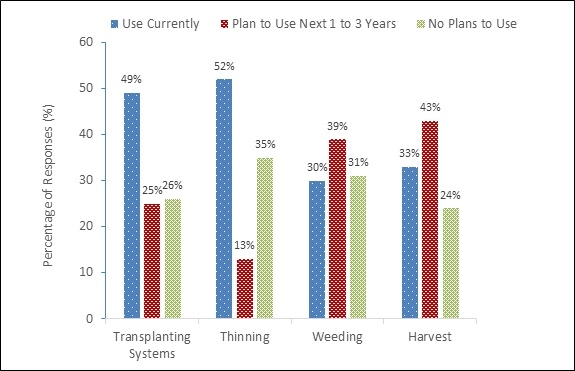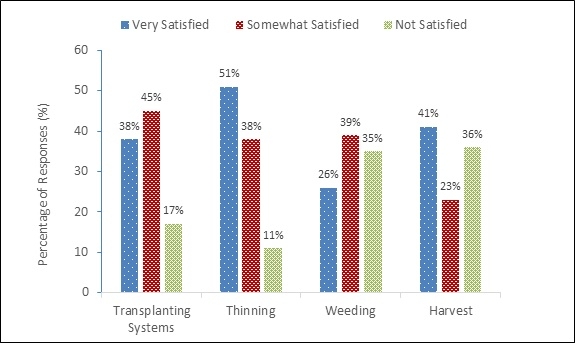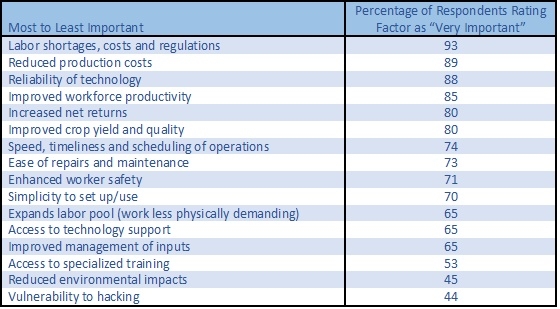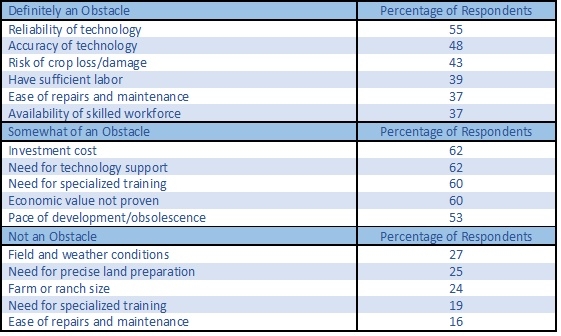Introduction. To gain insight into the agricultural industry and help develop research programs,the University of California and University of Arizona surveyed growers about their use of automated (mechanized) technologies in vegetable crops. The survey's goal was to determine the current use and potential for adoption, as well as to understand the reasons why industry may—or may not—adopt existing or new vegetable technologies. For the purposes of the survey, automated (mechanized) technologies were defined as automated devices that plant, thin, weed or harvest vegetable crops with limited use of hand labor.
Methods
The research team developed a 10-question survey to discern current use and level of satisfaction for automated technologies in planting, thinning, weeding and harvesting vegetable crops. By design, the questionnaire was kept short to encourage greater industry participation. Questions related to general farm characteristics were included to determine each respondent's primary role in the vegetable industry, farm size, crops grown and gross sales. The survey was administered in-person at UC Cooperative Extension's Salinas Valley Weed School on October 31, 2017 and at UCCE's Central Valley Fresh Market Tomato Meeting on February 28, 2018. Arizona vegetable growers were surveyed online between March 14 and April 1, 2018.
Results
The number of potential respondents was estimated at 203; 98 surveys were returned for a 48 percent response rate. Fifty-eight questionnaires were deemed complete (59 percent); 40 were partially completed (41 percent). All responses are reported here.
The technology most often used by responding participants was automated thinning, at 52 percent (Figure 1). It is also the technology that industry was most satisfied with, with 89 percent of respondents reporting they were either very satisfied for somewhat satisfied with the technology (Figure 2). Transplanting systems followed, with 49 percent of those that responded currently using the technology, and 83 percent satisfied with its use. This result is not surprising given the level of development and commercial availability of these technologies. Weeding technology is being used by only 30 percent of those responding, with 65 percent satisfied with its use; another 35 percent were not at all satisfied. Although the level of dissatisfaction for weeding technology is higher than for thinning or transplanting systems, 39 percent of those responding also report that they plan to increase its use in the future. From a marketing perspective, the data suggest that the automated thinning market is nearly saturated with only 13 percent of respondents indicating that they plan on becoming new users of the technology within the next 1 to 3 years. Conversely, the business opportunities for weeding and harvesting technologies appear to be larger with roughly 40 percent of respondents reporting they plan on adopting these technologies in the next 1 to 3 years. The supplemental comment “auto weeding is getting very important” supports this idea.
Harvest technology responses followed a pattern similar to weeding technology responses. This is very likely due to the labor intensive nature of the two practices, the labor constraints that growers


currently face, and the difficulty in developing technologies that could be used effectively as a substitute for, or at least a supplement to, field or manual labor. Indeed, several supplemental comments discuss the importance of developing harvest technology for industry. One comment: “the sooner these machines can be introduced in the harvesting area the better… it is the most labor intensive area of our business”. Another comment: “automation has to replace workers rather than just make the total number more productive… the reason is due to labor scarcity”.
In deciding to use automated technologies, 93 percent of those responding viewed labor constraints, costs and regulations as a “very important” factor (Table 1). This response may help explain, at least in part, respondents' plans to increase use of weeding and harvest technology in the future while at the same time reporting some level of dissatisfaction with its use (Figures 1 and 2). That is, industry may be inclined to adopt weed management (and other) technology as a supplement to, or as a substitute for, a shrinking labor pool and costly labor intensive practices, but may also feel that the technology is not yet advanced or precise enough to fully embrace. Supplemental comments, for example “good stuff but needs improvements”, “some of the technology is bonafied, and some is iffy at times”, and “I don't feel the industry is moving fast enough” offer support for this idea. Adding further support, the reliability of mechanized technology and its speed and timeliness in field operations were also reported as important by the majority of those industry participants that responded. Lower production costs and higher net returns were reported as additional important aspects for adoption of new technologies. This is not surprising given the known rising costs of labor and the thin profit margins that vegetable growers often face. About one-quarter to one-third of all participants indicated that they have no future plans to use one or more of the different technologies highlighted in this questionnaire. Although it is not clear why participants answered in this way, one comment “there are mechanical solutions that are less expensive…we do not always need computers and software if there are simple solutions” sheds some light on one potential reason. The least important indicators for automated technology adoption, with less than 45 percent of respondents ranking the factor as “very important”, were reduced environmental impacts and vulnerability to hacking.

Participants were also asked what factors may limit adoption of automated technologies. An unexpected result was that the majority of respondents indicated that investment cost and proven economic value were viewed as only “somewhat of an obstacle” (Table 2). Historically, these have been seen as significant barriers to adoption of new practices. When evaluated in the context of rising labor costs and limitations, advancements in technology and improved commercial availability in the future, these costs may no longer be seen as optional but rather necessary given current production conditions. The supplemental comments “labor shortage will drive this technology”, “speed of development is important, especially with labor challenges now” and “you are already behind if you do not have current focused engineering, software and fabrication programs in operation” support this idea. The need for technology support and specialized training were also seen as impediments to adoption rather than outright barriers. Interestingly, though, a smaller number of respondents also report that specialized training is not an obstacle. It may be that some operations already have staff with advanced technological know-how and are more at ease with new practices and production approaches. This may also help explain why precision land preparation and ease of repairs and maintenance were not seen as an obstacle by some. In contrast, lack of reliability or accuracy for mechanized equipment were reported as definite obstacles to adoption of new production methods by roughly half of all respondents. Adequate attention to both could improve acceptability and satisfaction with the use of any new technology in the future. Respondents also show some uneasiness with the pace of technological development and the possibility of relatively rapid obsolescence, a notable investment risk.

Thirty-five percent of questionnaire respondents described themselves as pest control advisers (PCA)/certified crop advisers (CCA), 28 percent as managers of operations, and another 23 percent were owners/principals. When asked to describe their attitude to adoption of new technologies or production methods, 69 percent fell into the category “I normally wait to see if new technology or production methods are successful before trying them”, with another 29 percent reporting that they are early adopters. A substantial portion of respondents declined to answer questions related to farm size, crops farmed and gross sales, however, partial indicators are reported here. Of those responding to the “acreage and crops farmed” questions, almost two-thirds indicated that they farm using both conventional and organic production approaches. Conventionally farmed operations are generally larger in size than organic operations, with the greatest number of large operations farming leafy greens and brassicas. This makes sense because the majority of all respondents were from regions in California and Arizona that have large production areas for both of these crop groups. Median farm size for the three different grower groups combined was 3,000 and 291 acres for conventional and organic, respectively. Sixty-five percent of those responding reported gross sales of more than $5 million, with another 17 percent reporting sales between $1 million and $5 million, further indicators of larger sized operations. The high value of the fresh market vegetable crops that are characteristic of the areas targeted here may also help to explain this result. It is important to note, however, that gross sales are not a measure of profitability and do not take into account production and harvest expenses.
Study Limitations. The survey results are from a relatively small group sample size and therefore may not represent the larger vegetable industry. Also, not all respondents chose to answer every question. The research team plans to survey additional growers during 2019, which will add to an understanding of use, satisfaction and obstacles limiting adoption of automated technologies.